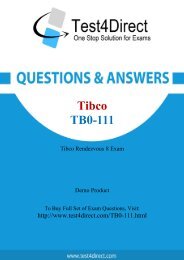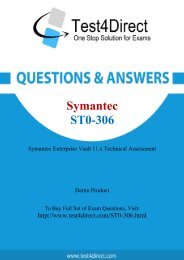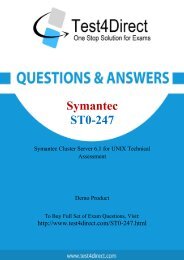S90-09A Latest Exam BrainDumps
Test4Direct provides latest PDF questions of Arcitura Education S90-09A exam. You have an opportunity to pass the Arcitura Education S90-09A exam in one go. Test4Direct is most accurate source to prepare Arcitura Education S90-09A exam as your success will become site’s responsibility after purchasing S90-09A exam product. There are also lots of discounts and promotion offers that you can avail. Let’s try a free demo http://www.test4direct.com/S90-09A.html
Test4Direct provides latest PDF questions of Arcitura Education S90-09A exam. You have an opportunity to pass the Arcitura Education S90-09A exam in one go. Test4Direct is most accurate source to prepare Arcitura Education S90-09A exam as your success will become site’s responsibility after purchasing S90-09A exam product. There are also lots of discounts and promotion offers that you can avail. Let’s try a free demo http://www.test4direct.com/S90-09A.html
Create successful ePaper yourself
Turn your PDF publications into a flip-book with our unique Google optimized e-Paper software.
Arcitura Education<br />
<strong>S90</strong>-<strong>09A</strong><br />
SOA Design & Architecture Lab<br />
Demo Product<br />
To Buy Full Set of <strong>Exam</strong> Questions, Visit:<br />
http://www.test4direct.com/<strong>S90</strong>-<strong>09A</strong>.html
Question: 1<br />
Service A is an entity service with a functional context dedicated to invoice-related processing.<br />
Service B is a utility service that provides generic data access to a database. In this service<br />
composition architecture, Service Consumer A sends a SOAP message containing an invoice XML<br />
document to Service A(1). Service A then sends the invoice XML document to Service B (2), which<br />
then writes the invoice document to a database. The data model used by Service Consumer A to<br />
represent the invoice document is based on XML Schema A . The service contract of Service A is<br />
designed to accept invoice documents based on XML Schema B . The service contract for Service B is<br />
designed to accept invoice documents based on XML Schema A . The database to which Service B<br />
needs to write the invoice record only accepts entire business documents in Comma Separated Value<br />
(CSV) format.<br />
Due to the incompatibility of the XML schemas used by the services, the sending of the invoice<br />
document from Service Consumer A through to Service B cannot be accomplished using the services<br />
as they currently exist. Assuming that the Contract Centralization pattern is being applied and that<br />
the Logic Centralization is not being applied, what steps can be taken to enable the sending of the<br />
invoice document from Service Consumer A to the database without adding logic that will increase<br />
the runtime performance requirements of the service composition?<br />
A. Service Consumer A can be redesigned to use XML Schema B so that the SOAP message it sends is<br />
compliant with the service contract of Service A . The Data Model Transformation pattern can then<br />
be applied to transform the SOAP message sent by Service A so that it conforms to the XML Schema<br />
A used by Service B . The Standardized Service Contract principle must then be applied to Service B<br />
and Service Consumer A so that the invoice XML document is optimized to avoid unnecessary<br />
validation.<br />
B. The service composition can be redesigned so that Service Consumer A sends the invoice<br />
document directly to Service B . Because Service Consumer A and Service B use XML Schema A, the<br />
need for transformation logic is avoided. This naturally applies the Service Loose Coupling principle<br />
because Service Consumer A is not required to send the invoice document in a format that is<br />
compliant with the database used by Service B .<br />
C. Service Consumer A can be redesigned to write the invoice document directly to the database.
This reduces performance requirements by avoiding the involvement of Service A and Service B . It<br />
further supports the application of the Service Abstraction principle by ensuring that Service<br />
Consumer A hides the details of the data access logic required to write to the database.<br />
D. None of the above.<br />
Question: 2<br />
Answer: B<br />
Service A is an entity service with a functional context dedicated to invoice-related processing.<br />
Service B is a utility service that provides generic data access to a database. In this service<br />
composition architecture, Service Consumer A sends a SOAP message containing an invoice XML<br />
document to Service A(1). Service A then sends the invoice XML document to Service B (2), which<br />
then writes the invoice document to a database. The data model used by Service Consumer A to<br />
represent the invoice document is based on XML Schema A . The service contract of Service A is<br />
designed to accept invoice documents based on XML Schema B . The service contract for Service B is<br />
designed to accept invoice documents based on XML Schema A . The database to which Service B<br />
needs to write the invoice record only accepts entire business documents in Comma Separated Value<br />
(CSV) format.<br />
Due to the incompatibility of XML schemas used by the services, the sending of the invoice<br />
document from Service Consumer A through to Service B cannot be accomplished using the services<br />
as they currently exist. Assuming that the Contract Centralization and Logic Centralization patterns<br />
are being applied, what steps can be taken to enable the sending of the invoice document from<br />
Service Consumer A to the database without adding logic that will increase the runtime performance<br />
of the service composition?<br />
A. The Data Model Transformation pattern can be applied so that the invoice document sent by<br />
Service Consumer A is transformed into an invoice document that is compliant with the XML Schema<br />
B used by Service A . The Data Model Transformation pattern can be applied again to ensure that the<br />
invoice document sent by Service A is compliant with XML Schema A used by Service B .<br />
B. The service composition can be redesigned so that Service Consumer A sends the invoice<br />
document directly to Service B . Because Service Consumer A and Service B use XML Schema A, the<br />
need for transformation logic is avoided. This naturally applies the Service Loose Coupling principle<br />
because Service Consumer A is not required to send the invoice document in a format that is<br />
compliant with the database used by Service B .
C. The Standardized Service Contract principle can be applied to the service contract of Service A so<br />
that it is redesigned to use XML Schema A . This would make it capable of receiving the invoice<br />
document from Service Consumer A and sending the invoice document to Service B without the<br />
need to further apply the Data Model Transformation pattern.<br />
D. None of the above.<br />
Question: 3<br />
Answer: C<br />
The Client and Vendor services are agnostic services that are both currently part of multiple service<br />
compositions. As a result, these services are sometimes subjected to concurrent access by multiple<br />
service consumers. The Client service is an entity service that primarily provides data access logic to<br />
a client database but also provides some calculation logic associated with determining a client's<br />
credit rating. The Vendor service is also an entity service that provides some data access logic but can<br />
also generate various dynamic reports. After reviewing historical statistics about the runtime activity<br />
of the two services, it was discovered that the majority of concurrent runtime access is related to the<br />
processing of business rules. With the Client service, it is the calculation logic that is frequently<br />
required and with the Vendor service it is the dynamic reporting logic that needs to be accessed<br />
separately from the actual report generation.<br />
Currently, due to the increasing amount of concurrent access by service consumers, the runtime<br />
performance of both the Client and Vendor services has worsened and has therefore reduced their<br />
effectiveness as service composition members. What steps can be taken to solve this problem<br />
without introducing new services?<br />
A. The Rules Centralization pattern can be applied by extracting the business rule logic from the
Client and Vendor services and placing it into a new Rules service. This will naturally improve the<br />
runtime performance of the Client and Vendor services because they will no longer be subjected to<br />
the high concurrent access of service consumers that require access to the business rules logic.<br />
B. The Redundant Implementation pattern can be applied to the Client and Vendor services, thereby<br />
establishing duplicate implementations that can be accessed when a service reaches its runtime<br />
usage threshold. The Intermediate Routing pattern can be further applied to provide load balancing<br />
logic that can, at runtime, determine which of the redundant service implementations is the least<br />
busy for a given service consumer request.<br />
C. The Rules Centralization pattern can be applied together with the Redundant Implementation<br />
pattern to establish a scalable Rules service that is redundantly implemented and therefore capable<br />
of supporting high concurrent access from many service consumers. The Service Abstraction principle<br />
can be further applied to hide the implementation details of the Rules service.<br />
D. None of the above.<br />
Question: 4<br />
Answer: B<br />
Currently, due to the increasing amount of concurrent access by service consumers, the runtime<br />
performance of both the Client and Vendor services has worsened and has therefore reduced their<br />
effectiveness as service composition members. Additionally, a review of the logic of both services<br />
has revealed that some of the business rules used by the Client and Vendor services are actually the<br />
same. What steps can be taken to improve performance and reduce redundant business rule logic?<br />
A. The Rules Centralization pattern can be applied by extracting the business rule logic from the<br />
Client and Vendor services and placing it into a new Rules service, thereby reducing the redundancy<br />
of business rules logic. The Redundant Implementation pattern can then be applied to establish a<br />
scalable Rules service that is capable of supporting concurrent access from many service consumers.<br />
B. The Redundant Implementation pattern can be applied to the Client and Vendor services, thereby<br />
establishing duplicate service implementations that can be accessed when a service reaches its<br />
runtime usage threshold. The Intermediate Routing pattern can be further applied to provide load<br />
balancing logic that can, at runtime, determine which of the redundant service implementations is<br />
the least busy for a given service consumer request.<br />
C. The Rules Centralization pattern can be applied to isolate business rules logic into a central and<br />
reusable Rules service. Additionally, the Service Abstraction principle can be applied to hide the<br />
implementation details of new the Rules service.<br />
D. None of the above.<br />
Answer: A
THANKS FOR TRYING THE DEMO OF OUR PRODUCT<br />
Visit Our Site to Purchase the Full Set of Actual <strong>S90</strong>-<strong>09A</strong> <strong>Exam</strong> Questions With Answers.<br />
http://www.test4direct.com/<strong>S90</strong>-<strong>09A</strong>.html<br />
We Also Provide Practice <strong>Exam</strong> Software That Simulates Real <strong>Exam</strong> Environment And Has<br />
Many Self-Assessment Features. Download Free Product Demo From:<br />
http://www.test4direct.com/<strong>S90</strong>-<strong>09A</strong>.html<br />
Money Back Guarantee<br />
Check Out Our Customer Testimonials

















